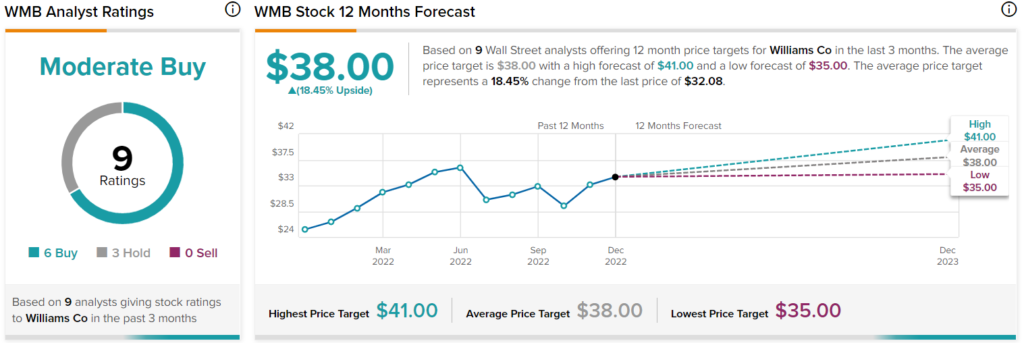Wall Street has a love/hate relationship with natural gas pipelines. Most investors hate the companies that operate them for ESG reasons. However, these are complicated times, so in this piece, I compared two pipeline stocks to see which is better.
Discover the Best Stocks and Maximize Your Portfolio:
- See what stocks are receiving strong buy ratings from top-rated analysts.
- Filter, analyze, and streamline your search for investment opportunities with TipRanks’ Stock Screener.

Ultimately, the appropriate views on Kinder Morgan (NYSE:KMI) and The Williams Companies (NYSE:WMB) depend on what kind of investor is reviewing them. On the surface, both look like attractive dividend plays for passive income investors, but digging a bit deeper, we find reasons for non-income investors to potentially choose one over the other.
Kinder Morgan (KMI)
At first glance, Kinder Morgan has a clear advantage over Williams Co. due to its higher dividend yield of 6.4% and lower trailing P/E multiple of 16.3 times. Kinder Morgan is up only 17% year-to-date versus Williams’ gain of 32%, and a closer look reveals it also has a better debt-to-equity ratio. For these reasons, a bullish view looks appropriate for Kinder Morgan.
Since Russia invaded Ukraine, the energy crisis has been a major story, with concerns about a natural gas shortage now coming to a head. Kinder Morgan should benefit from the increased demand for this commodity as the U.S. increases its exports to Europe to help replace some of the supply that previously came from Russia.
With about 70,000 miles of natural gas pipelines that transport over 40% of the gas volume in the U.S., Kinder Morgan operates the largest network in the U.S., putting it in pole position on the gas shortage. Although the company missed earnings estimates in the third quarter, it reported strength in its gas pipelines.
Additionally, Kinder Morgan’s holdings in the Permian Basin have long been particularly attractive, and the company is expanding its Permian Highway Pipeline to support the increased gas demand. To please ESG enthusiasts, the company is turning its attention to cleaner energy via carbon-capture technologies and the transportation of green hydrogen.
Finally, Kinder Morgan has a solid balance sheet, although the expansion of its Permian pipelines has taken a bite out of its cash levels. The company had $1.14 billion in cash and equivalents at the end of 2021, but that dropped to $483 million in the most recent quarter.
Nonetheless, Kinder Morgan has about $70 billion in assets and $38 billion in total liabilities. Its debt-to-equity position stands at 100% as of the most recent quarter, which isn’t great overall, but it’s been holding steady and is attractive compared to other pipeline companies.
What is the Price Target for KMI Stock?
Kinder Morgan has a Moderate Buy consensus rating based on three Buy ratings, five Holds, and zero Sells over the last three months. At $20.38, the average price target for Kinder Morgan implies upside potential of 16.2%.

The Williams Companies (WMB)
As a direct competitor with similar scale, Williams Co. enjoys many of the same macro benefits as Kinder Morgan in terms of the natural gas shortage. However, Williams’ P/E multiple is higher than Kinder Morgan’s, and its balance sheet and debt position aren’t as attractive. Williams also has a lower dividend yield. Thus, a neutral view looks appropriate.
After this year’s sizable rally, Williams Co. is trading at a trailing P/E of around 20.4 times, making it look slightly overvalued compared to Kinder Morgan. Williams’ balance sheet is OK, with $859 million in cash and equivalents, $48.67 billion in total assets, and $34.8 billion in total liabilities as of Q3 2022.
The company’s debt-to-equity ratio position stands at 168%. Williams and Kinder Morgan are on par with each other in free cash flow, generating $3 billion and $2.8 billion, respectively, for the last 12 months.
Additionally, Williams’ dividend yield is slightly smaller at about 5%. Finally, it’s also trying to woo ESG investors by tapping solar power for its own operations and looking into renewable natural gas, carbon capture, and other technologies.
What is the Price Target for WMB Stock?
Williams Co. has a Strong Buy consensus rating based on six Buys, three Holds, and zero Sell ratings assigned over the last three months. At $38.00, the average price target for Williams Co. implies upside potential of 18.45%.

Conclusion: Bullish on KMI, Neutral on WMB
Overall, pipeline companies can be excellent investments due to their high dividends and steady cash flows. In fact, income investors will find both Kinder Morgan and Williams Co. attractive for their dividend yields, potentially making both worth holding due to their similarities and the attractive macro environment.
However, value investors may need a bit more motivation and may only want to choose one, so a deep dive into both companies’ multiples and balance sheets gives Kinder Morgan a slight advantage.









